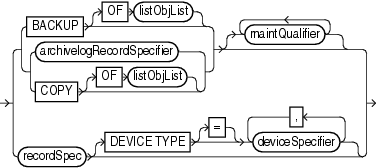| Oracle® Database Backup and Recovery Reference 10g Release 2 (10.2) Part Number B14194-03 |
|
|
PDF · Mobi · ePub |
| Oracle® Database Backup and Recovery Reference 10g Release 2 (10.2) Part Number B14194-03 |
|
|
PDF · Mobi · ePub |
crosscheck::=
maintSpec::=

To verify the status of backups and copies recorded in the RMAN repository against media such as disk or tape. The CROSSCHECK command only processes files created on the same device type as the channels running the crosscheck.
The CROSSCHECK command checks only objects marked AVAILABLE or EXPIRED by examining the files on disk for DISK channels or by querying the media manager for sbt channels. Table 2-2 describes the meaning of each status.
Table 2-2 Meaning of Crosscheck Status
| Status | Description |
|---|---|
|
|
Object is not found either in file system (for Note: |
|
|
Object is available for use by RMAN. For a backup set to be |
|
|
Object is not available for use by RMAN. For a backup set to be |
The CROSSCHECK command does not delete any files that it is unable to find, but updates their repository records to EXPIRED. Then, you can run DELETE EXPIRED to remove the repository records for all expired files as well as any existing physical files whose records show the status EXPIRED.
If some backup pieces or copies were erroneously marked as EXPIRED, for example, because the media manager was misconfigured, then after ensuring that the files really do exist in the media manager, run the CROSSCHECK BACKUP command again to restore those files to AVAILABLE status.
See Also:
Oracle Database Backup and Recovery Basics to learn how to manage target database records in the catalogThe target instance must be started.
A maintenance channel is not required when CROSSCHECK is used with a file that is on disk. However, if you run CROSSCHECK on files stored on a media manager, and you have not configured automatic channels for the media manager, then you must manually allocate maintenance channels for these objects. For example, if you created a backup on an sbt channel, but have not configured automatic channels for your sbt device, then you must manually allocate an sbt channel before the CROSSCHECK command can check the backup.
Crosscheck validates all specified backups and copies, even if they were created in prior incarnations (that is, before the most recent OPEN RESETLOGS).
| Syntax Element | Description |
|---|---|
| maintSpec | Crosschecks files output by the BACKUP command. For maintSpec options, refer to the parameter descriptions in "maintSpec". |
Crosschecking All Backups and Copies: Example The following example, which assumes that the default configured channel is DEVICE TYPE sbt, queries the status of all backups and copies on tape and disk. Because RMAN preconfigures a disk channel, you do not need to manually allocate a disk channel:
CROSSCHECK BACKUP; # crosschecks backup sets and image copies
Crosschecking Within a Range of Dates: Example The following example queries the media manager for the status of the backup sets in a given six month range. Note that RMAN uses the date format specified in the NLS_DATE_FORMAT parameter, which is 'DD-MON-YY' in this example:
# if you manually allocate an sbt channel, then RMAN does not crosscheck disk ALLOCATE CHANNEL FOR MAINTENANCE DEVICE TYPE sbt; CROSSCHECK BACKUP COMPLETED BETWEEN '01-JAN-01' AND '01-SEP-01'; RELEASE CHANNEL; # to crosscheck only disk, specify CROSSCHECK DEVICE TYPE DISK CROSSCHECK BACKUP DEVICE TYPE DISK COMPLETED BETWEEN '01-JAN-01' AND '01-SEP-01'; # assuming that the default channel is sbt, you can crosscheck on both disk # and sbt backups by simply running CROSSCHECK with the default channels CROSSCHECK BACKUP COMPLETED BETWEEN '01-JAN-01' AND '01-SEP-01';